Formation of the Solar System: Nuclear Disc Model (neo-Laplacian model)
- Nebular Theory of Laplace (1796) tried to explain the formation of the solar system. But it had many drawbacks as the theory was based on scientifically erroneous assumptions.
- But one assumption it got right was that the solar system was born from a giant gas of dust called as nebula.
- A giant interstellar cloud known as the solar nebula (a vast, swirling cloud of gas and dust) gave birth to our solar system and everything in it.
- The nebula started its collapse and core formation some 5-5.6 billion years ago and the Sun and the planets were formed about 4.6 billion years ago.
Formation of the Sun
- The nebula began to collapse (gravitational collapse) in on itself after becoming gravitationally unstable.
- This was possibly because of a nearby supernova sending shock waves rippling through space.
- Gravity then caused dust and gas to coalesce to the centre of the nebular cloud.
- As more matter got pulled in, the centre got denser and hotter, increasing the gravity and pulling even more dust inwards causing a snowball effect.
- About 99.9% of the material fell into the centre and became the protosun (no sunlight yet).
- Once the centre of the cloud became hot enough it triggered nuclear fusion, and the Sun was born.
The formation of planets
- The 0.1% of matter that remained orbited around the Sun, causing the randomly shaped gas cloud to form a flat disc shape.
- This flat disc, called the protoplanetary disc, was where the planets formed.
- Within the solar nebula, the dust particles in the gas occasionally collided and clumped together.
- Through this process called accretion, the microscopic particles formed larger bodies that eventually became planetesimals (infant stage of a planet) with sizes up to a few kilometres across.
- As the disc continued to cool, the planetesimals grew in size through accretion to form protoplanets.
- Gradually they got larger and larger, sweeping up all the leftover dust, other protoplanets, planetesimals until they grew into the planets.
- In the inner, hotter part of the solar nebula, planetesimals were composed mostly of silicates and metals.
- In the outer, cooler portion of the nebula, water ice was the dominant component.
- The hot, rocky material near the centre of the solar system gave rise to terrestrial planets with metal cores (mostly composed of iron and nickel): Mercury, Venus, Earth and Mars.
- And on the cool edges, the gas and ice giants were born: Saturn, Jupiter, Neptune, and Uranus.
- Rocks that escaped the pull of planets were left as asteroids, scattered through the solar system.
- Many of these rocks orbit the Sun in an area between Mars and Jupiter known as the asteroid belt.

Formation of the Solar System: Nuclear Disc Model (Source)
Iron Catastrophe and Planetary differentiation
- When Earth was formed about 4.5 billion years ago, it was a uniform ball of hot rock.
- Radioactive decay and leftover heat from planetary formation caused the ball to get even hotter.
- Eventually, after about 500 million years, our young planet’s temperature heated to the melting point of iron — about 1,538° Celsius.
- This pivotal moment in Earth’s history is called the iron catastrophe.
- The iron catastrophe allowed greater, more rapid movement of Earth’s molten, rocky material.
- Relatively buoyant material, such as silicates, water, and even air, stayed close to the planet’s exterior.
- Droplets of iron, nickel, and other heavy metals gravitated to the centre of Earth, becoming the early core.
- This important process is called planetary differentiation.
Components of the Solar System
- Our solar system consists of the sun, eight major planets, dwarf planets (Pluto, Ceres, Eris etc.), satellites and countless minor planets, asteroids, meteors, comets and debris.
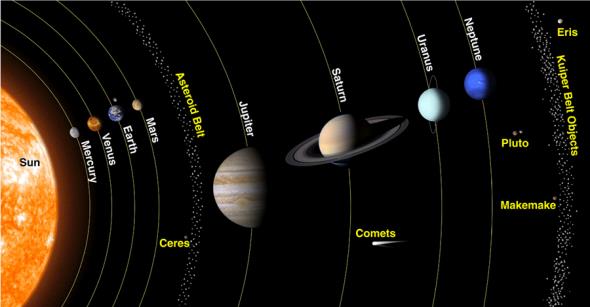
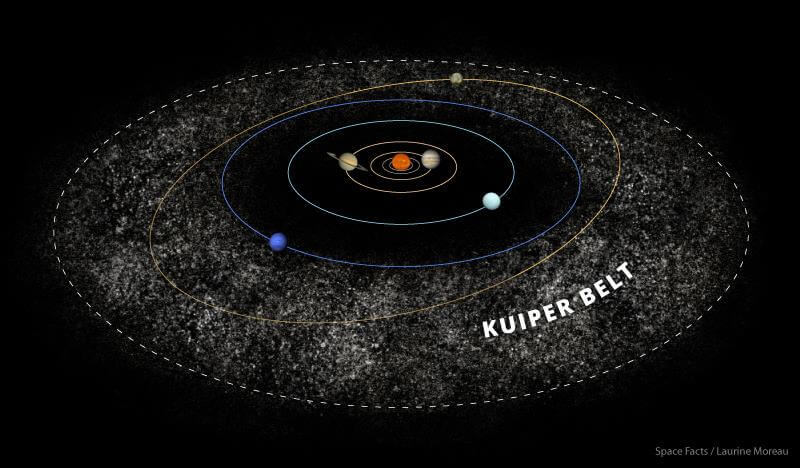
Components of the Solar System
Sun’s Internal Structure and Atmosphere, Solar Wind
Components of the Solar System
- Our solar system consists of the sun, eight major planets, dwarf planets (Pluto, Ceres, Eris etc.), satellites and countless minor planets, asteroids, meteors, comets and debris.
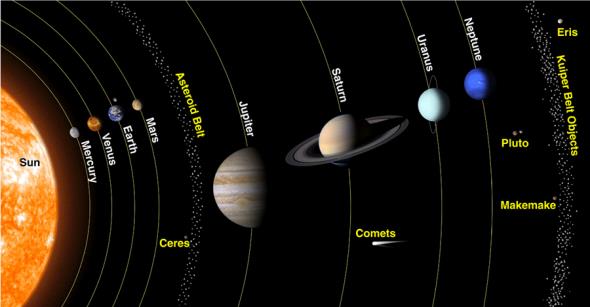
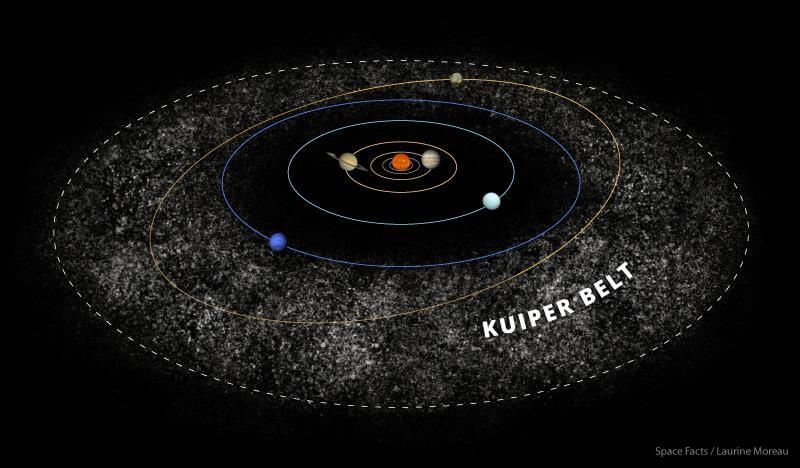
Components of the Solar System
The Sun
- Age: 4.6 billion years.
- Diameter: 1.39 million km.
- Temperature: 6000 °C on surface and 16 million °C in core.
- Density: 1.41 times that of water.
Density of water = 999.97 kg/m³ = ~ 1 g/cm3;
Density of Iron = 7870 kg/m³.
That implies Iron is = 7.87 times denser than water. In comparison, earth is about 5.5 times denser than water.
- The surface gravity of the Sun is 274 m/s2 (28 times the gravity of the Earth).
- Comparatively, the surface gravity of the earth and moon are 9.8 m/s2 and 1.62 m/s2 respectively.
- Period of rotation: 25 days 9 hrs.
- Speed of rotation: 7179.73 km/hrs. Comparatively, earth’s rotational velocity is 1675Km/hrs.
- Sun is equivalent to 3,32,900 Earth masses.
- Stars like Sun are rare in Milky Way galaxy, whereas substantially dimmer and cooler stars, known as red dwarfs, are common.
- The Sun is composed of roughly 98% hydrogen and helium.
- The vast majority of the solar system’s mass is in the Sun (~99.8%), with most of the remaining mass contained in Jupiter and Saturn.
- Although the Sun dominates the system by mass, it accounts for only about 2% of the angular momentum due to the differential rotation within the gaseous Sun.
- Sun is rotating in counter-clockwise direction (when viewed from a long way above Earth’s north pole).
- Those objects closer to the Sun, which are more affected by heat and light pressure, are composed of elements with high melting points.
- Objects farther from the Sun are composed largely of materials with lower melting points.
The Sun’s Internal Structure and Atmosphere
- The solar interior, from the inside out, is made up of the core, radiative zone and the convective zone.
- The solar atmosphere above that consists of the photosphere, chromosphere, and the corona (solar wind is an outflow of gas from the corona).
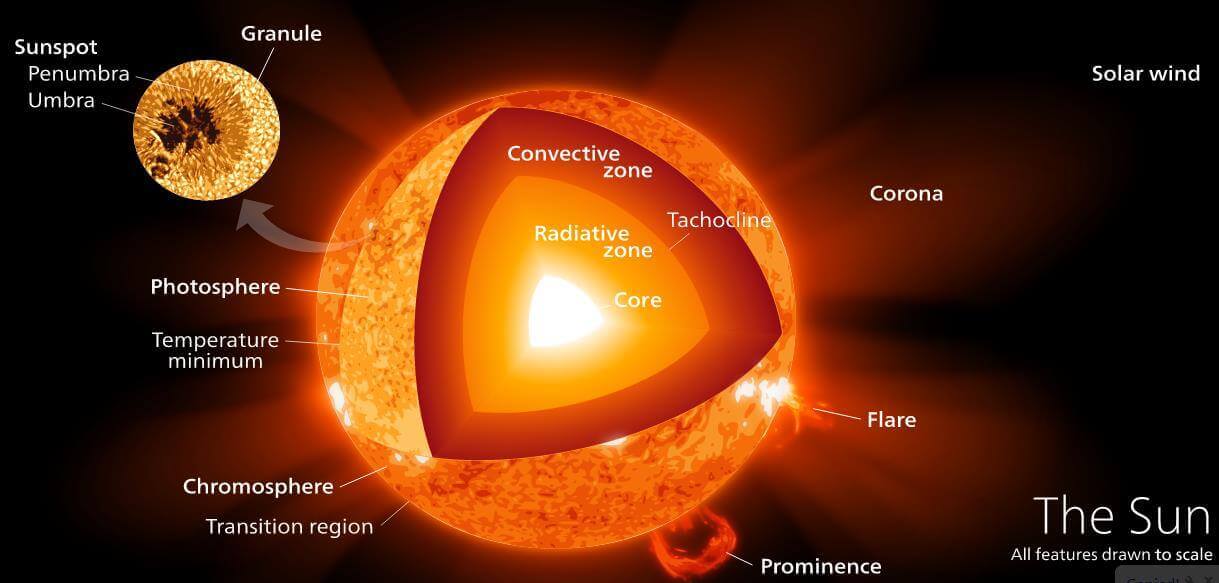
The Sun’s Internal and External Structure
Photosphere
- The photosphere is the bright outer layer of the Sun that emits most of the radiation.
- The photosphere is an extremely uneven surface.
- The effective temperature on the outer side of the photosphere is 6000°C.
Chromosphere
- Just above the photosphere is the chromosphere.
- It is relatively a thin layer of burning gases.
- The chromosphere is a bit cooler — 4,320 ֯C.
Sunspot
- A dark patch on the surface of the Sun is known as a sunspot.
- Sunspots appear as dark areas because they are about 500-1500°C cooler than the surrounding chromosphere.
- The individual sunspot has a lifetime ranging from a few days to a few months.
- Each spot has a black centre or umbra, and a lighter region or penumbra, surrounding it.
- It has been suggested that the Sun is 1% cooler when it has no sunspot and that this variation in solar radiation might affect the climates of the Earth.
Solar Wind
- The solar wind is a stream of energised, charged particles, primarily electrons and protons, flowing outward from the Sun at speeds as high as 900 km/s and at a temperature of 1 million degrees (Celsius).
- It is made of plasma (ionised atoms).
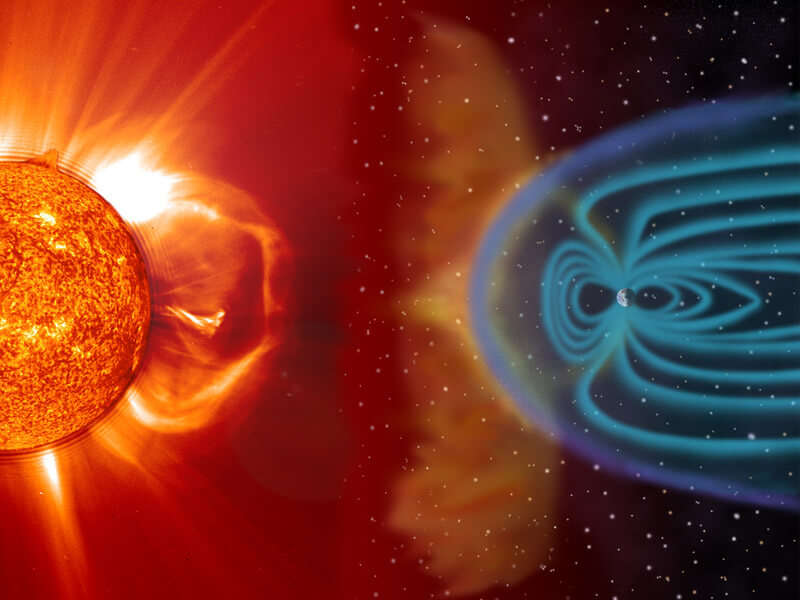
Effects of solar wind – Aurora
- An aurora is a natural light display in the sky, predominantly seen in the high latitude (Arctic and Antarctic) regions. (This is due to magnetic field lines of earth and solar wind)
- Auroras are caused by charged particles, mainly electrons and protons, entering the atmosphere from above causing ionisation and excitation of atmospheric constituents, and consequent optical emissions.

Effects of solar wind – Some planets have atmosphere whereas others don’t
- As the solar wind approaches a planet that has a well-developed magnetic field (such as Earth, Jupiter and Saturn), the particles are deflected.
- This region, known as the magnetosphere, causes the particles to travel around the planet rather than bombarding the atmosphere or surface.
- The magnetosphere is roughly shaped like a hemisphere on the side facing the Sun, then is drawn out in a long trail on the opposite side.
- The boundary of this region is called the magnetopause, and some of the particles are able to penetrate the magnetosphere through this region by partial reconnection of the magnetic field lines.
- The solar wind is responsible for the overall shape of Earth’s magnetosphere.
- Moreover, planets with a weak or non-existent magnetosphere are subject to atmospheric stripping by the solar wind.
- Venus, the nearest and most similar planet to Earth in the Solar System, has an atmosphere 100 times denser than our own, with little or no geomagnetic field. This is a strange exception.
Solar flares
- Solar flares are produced on the sun’s surface due to magnetic anomalies.
- They are magnetic storms which appear to be very bright spots with a gaseous surface eruption.
- As solar flares are pushed through the corona, they heat its gas to anywhere from 10 to 20 million °C.
Solar prominence
- An arc of gas that erupts from the surface of the Sun is called solar prominence.
- Prominences can loop hundreds of thousands of miles into space.
- Prominences are held above the Sun’s surface by strong magnetic fields and can last for many months.
- At some time in their existence, most prominences will erupt, spewing enormous amounts of solar material into space.
Corona
- A corona is a distinctive atmosphere of plasma that surrounds the Sun and other celestial bodies.
- The Sun’s corona extends millions of kilometres into space and is most easily seen during a total solar eclipse.
- Sun’s Corona visible during Total Solar Eclipse

Sun’s Corona visible during Total Solar Eclipse
Plasma
- Plasma is one of the four fundamental states of matter, the others being solid, liquid, and gas.
- Plasma is ionised gas (atoms and molecules are converted into ions typically by removing one or more electrons from the outer shell)
- Lightning and electric sparks are everyday examples of phenomena made from plasma.
- Neon lights could more accurately be called ‘plasma lights’, because the light comes from the plasma inside of them.
Planets of the Solar System & Other Solar System Objects
Planets
- A celestial body moving in an elliptical orbit around a star is known as a planet.
- The planets of our solar system are divisible in two groups:
- the planets of the inner circle (as they lie between the sun and the belt of asteroids) or the inner planets or the ‘terrestrial planets’ (meaning earth-like as they are made up of rock and metals, and have relatively high densities) and
- the planets of the outer circle or outer planets or the ‘gas giant planets’ or the Jovian planets – meaning Jupiter-like.
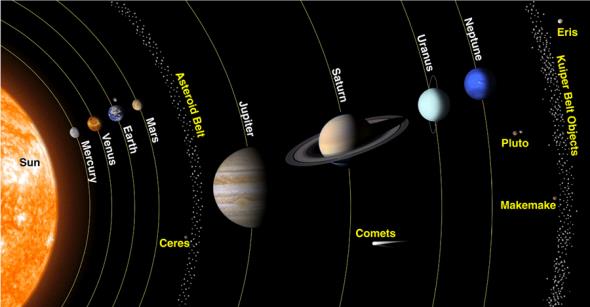
- The inner circle consists of four planets (Mercury, Venus, Earth and Mars) having smaller and denser bodies while the outer circle comprises four planets (Jupiter, Saturn, Uranus, and Neptune) having a larger size and less dense materials and have a thick atmosphere, mostly of helium and hydrogen
- Jovian planets are more like the sun than like the terrestrial planets.
- If we take Jupiter, the biggest planet, as the centre of the planets of our solar system, the size of the planets becomes smaller as we go away from either side of Jupiter (Mars being the exception).
- The orbits of the planets are nearly circular, but many comets, asteroids, and Kuiper belt objects follow highly elliptical orbits.
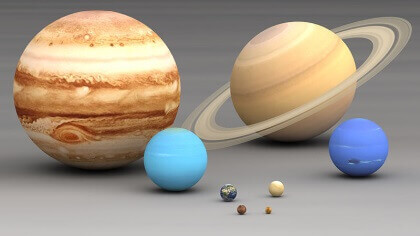
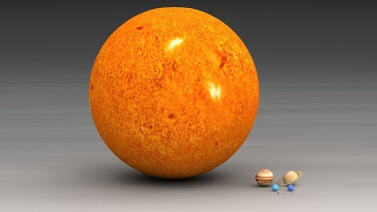
An Astronomical Unit (AU) is the average distance between Earth and the Sun, which is about 150 million km.
Values
in the given in the table are not accurate. They are rounded off for obvious
reasons
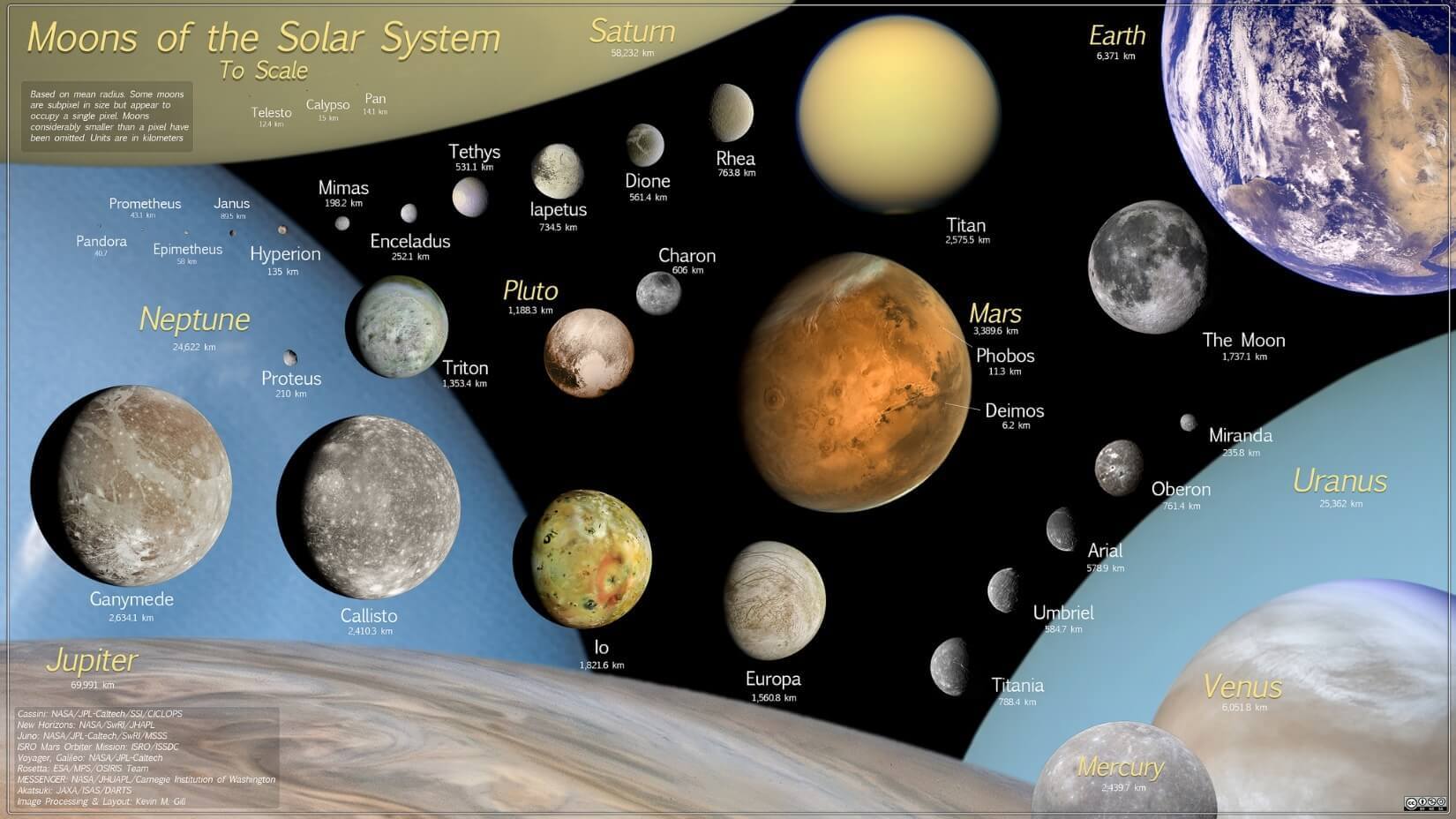
Major Moons of Various Planets (Source)

Size comparison of largest moons in the Solar System (User:primefac, via Wikimedia Commons)
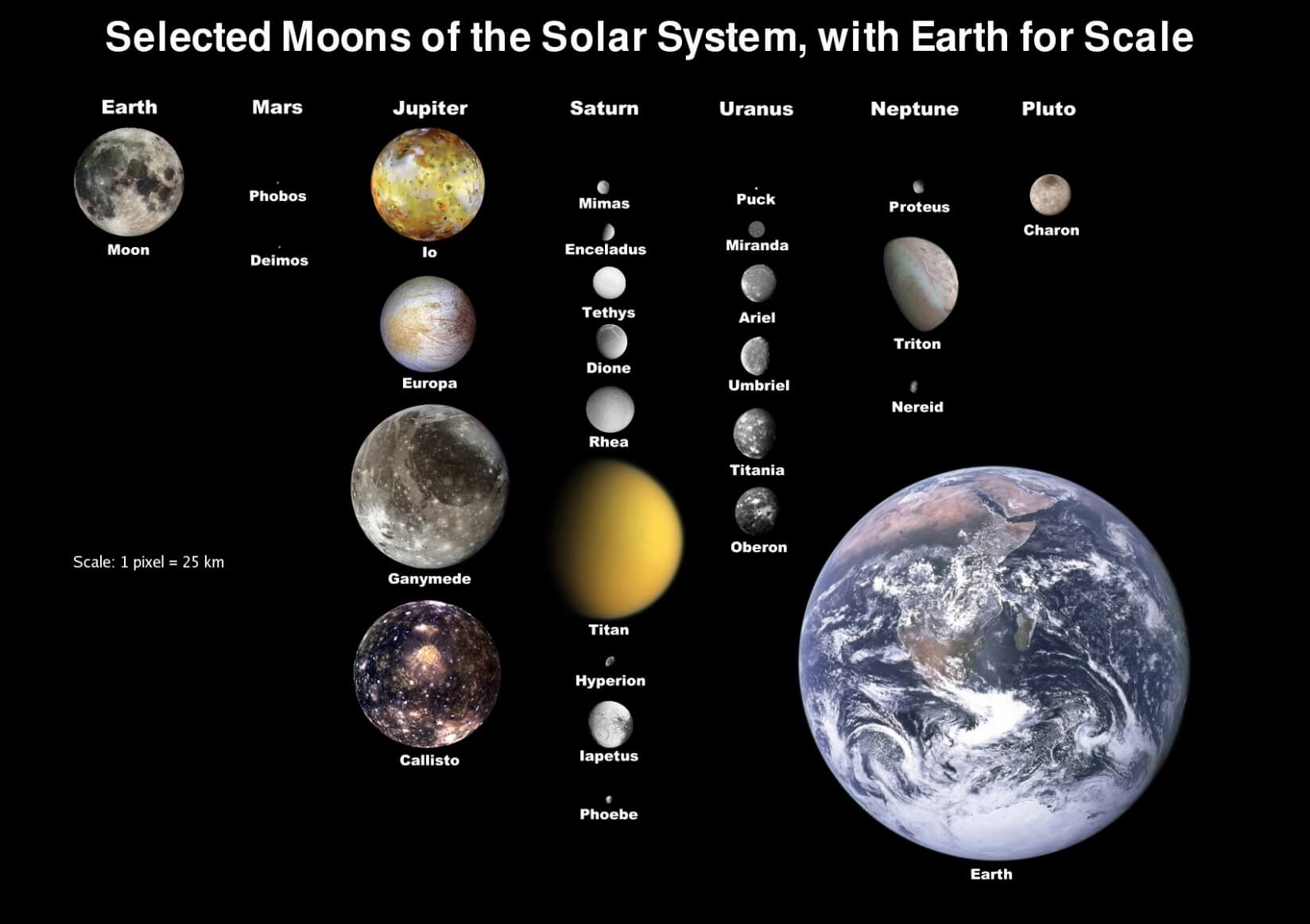
Size comparison of the largest moons with earth
Inner Planets
- The inner Solar System is the traditional name for the region comprising the terrestrial planets and asteroids.
- They are composed mainly of silicates and metals.
- The four inner or terrestrial planets have dense, rocky compositions, few or no moons, and no ring systems.
- They are composed largely of refractory minerals, such as the silicates, which form their crusts and mantles, and metals, such as iron and nickel, which form their cores.
- Three of the four inner planets (Venus, Earth and Mars) have atmospheres substantial enough to generate weather; all have impact craters and tectonic surface features, such as rift valleys and volcanoes.
- The term inner planet should not be confused with the inferior planet, which designates those planets that are closer to the Sun than Earth is (i.e. Mercury and Venus).
- The term superior planet designates planets outside Earth’s orbit and thus includes both the outer planets and Mars.
Mercury
- Mercury’s surface appears heavily cratered and is similar in appearance to the Moon’s, indicating that it has been geologically inactive for billions of years (because there is no atmosphere on Mercury).
- When viewed from Earth, the planet can only be seen near the western or eastern horizon during the early evening or early morning.
- It may appear as a bright star-like object but is less bright than Venus.
- Having almost no atmosphere to retain heat, it has surface temperatures that vary diurnally more than on any other planet in the Solar System (−173 °C at night to 427 °C during the day).
- Mercury is smaller than the largest natural satellites in the Solar System, Ganymede (largest moon of Jupiter) and Titan (largest moon of Saturn).
- However, Mercury is massive (has more mass) than Ganymede and Titan.
- Images obtained by MESSENGER spacecraft in 2004 have revealed evidence for pyroclastic flows (vulcanicity) and water ice at Mercury’s poles.
Venus
- Venus is the brightest planet in the solar system and is the third brightest object visible from earth after the sun and the moon.
- It is the brightest among planets because it has the highest albedo due to the highly reflective sulfuric acid that covers its atmosphere. It is sometimes visible to the naked eye in broad daylight.
- Venus is sometimes called Earth’s sister planet or Earth’s twin because of their similar size, mass, proximity to the Sun, bulk composition and presence of similar physical features such as high plateaus, folded mountain belts, numerous volcanoes, etc.
- It is radically different from Earth in other respects. The surface of Venus is totally obscured by a thick atmosphere composed of about 96% carbon dioxide, covered with clouds of highly reflective sulfuric acid.
- It has the densest atmosphere of the four terrestrial planets. The atmospheric pressure at the planet’s surface is 92 times that of Earth, or roughly the pressure found 900 m (3,000 ft) underwater on Earth.
- Venus is by far the hottest planet in the Solar System, even though Mercury is closer to the Sun.
- This is because of the greenhouse effect arising from high concentrations of CO2 and thick atmosphere.
- A day on Venus is equivalent to 243 earth days and lasts longer than its year (224 days).
- It rotates in the opposite direction (clockwise) to most other planets.
- In the ancient literature, Venus was often referred to as the morning star and evening star.
Moon
- Its diameter is only one-quarter that of the earth.
- It is about 3,84,400 km away from us.
- A ray of light from the sun takes about eight minutes to reach the earth. Light takes only a second to reach us from the moon.
- The moon is tidally locked to the earth, meaning that the moon revolves around the earth in about 27 days which is the same time it takes to complete one spin.
- Tidal locking is the name given to the situation when an object’s orbital period matches its rotational period.
- As a result of tidal locking, only one side of the moon is visible to us on the earth.
- The moon is a significant stabiliser of Earth’s orbital axis. Without it, Earth’s tilt could vary as much as 85 degrees (at present the Earth’s axis of rotation is tilted at an angle of 23.5֯ relative to our orbital plane).
- Neil Armstrong was the first, and Buzz Aldrin was the second to step on the surface of the moon on 29 July 1969 (Apollo 11 mission).
- Till date, only Twelve astronauts walked on the Moon’s surface.
Formation of the moon
- It is now generally believed that the formation of the moon, as a satellite of the earth, is an outcome of ‘giant impact’ or what is described as ‘the big splat’.
- A body of the size of one to three times that of mars collided into the earth sometime shortly after the earth was formed. It blasted a large part of the earth into space.
- This portion of blasted material then continued to orbit the earth and eventually formed into the present moon about 4.44 billion years ago.
- Scientists estimate that a day in the life of early Earth was only about 6 hours long.
- The Moon formed much closer to Earth than it is today.
- As Earth rotates, the Moon’s gravity causes the oceans to seem to rise and fall. There is a little bit of friction between the tides and the turning Earth, causing the earth’s rotation to slow down just a little (1.4 milliseconds in 100 years).
- As Earth slows, it lets the Moon move away by a little (four centimetres per year).
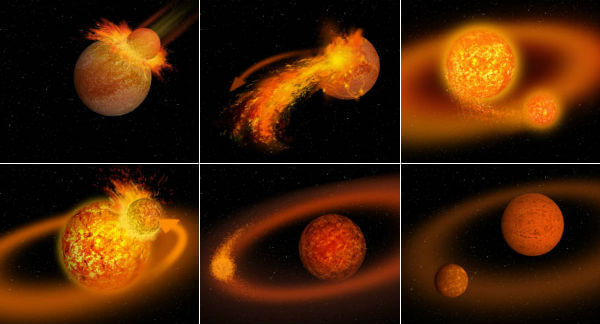
Colonizing the moon
- Discovery of lunar water at the lunar poles by Chandrayaan-1 has renewed interest in the Moon.
- Locations on the Lunar poles avoid the problem of long lunar nights (350+ hours).
- Exploration of the lunar surface by spacecraft began in 1959 with the Soviet Union’s Luna program.
- Luna 2 made a hard landing (impact) into its surface and became the first artificial object on the moon.
- Crewed exploration of the lunar surface began in 1968 when the Apollo 8 spacecraft orbited the Moon.
- The following year, the Apollo 11 Apollo Lunar Module landed two astronauts on the Moon.
- In 2009, the Chandrayaan probe discovered that the lunar soil contains 0.1% water by weight.
Advantages of colonising the moon
- A lunar base could be a site for launching rockets with locally manufactured fuel to distant planets.
There are several disadvantages to the Moon as a colony site
- The long lunar night would impede reliance on solar power.
- The Moon is highly depleted in carbon and volatile elements, such as nitrogen and hydrogen.
- The low gravity on the Moon will have adverse effects on human health in the long term.
- The lack of a substantial atmosphere results in temperature extremes, harmful radiation reaching the surface and increased chances of the colony’s being hit by meteors.
- Growing crops on the Moon is difficult due to the long lunar night, extreme variation in surface temperature, exposure to solar flares, nitrogen-poor soil, and lack of insects for pollination.
Mars
- Mars is often referred to as the “Red Planet” because of the reddish iron oxide prevalent on its surface.
- Mars has a thin atmosphere and has surface features ranging from impact craters of the Moon and the valleys, deserts, and polar ice caps of Earth.
- Mars is the site of Olympus Mons (shield volcano), the largest volcano and the highest known mountain (24 km) in the Solar System, and of Valles Marineris, one of the largest canyons in the Solar System.
- Mars has two irregularly shaped moons, Phobos and Deimos, which are thought to be captured asteroids.
- Liquid water cannot exist on the surface of Mars due to low atmospheric pressure (less than 1% of the Earth’s).
- The two polar ice caps appear to be made largely of water.
- Mars can easily be seen from Earth with the naked eye.
- Mars is less dense than Earth, having about 15% of Earth’s volume and 11% of Earth’s mass.
- Landforms visible on Mars strongly suggest that liquid water has existed on the planet’s surface.
- Mars lost its magnetosphere 4 billion years ago, possibly because of numerous asteroid strikes, so the solar wind interacts directly with the Martian ionosphere, lowering the atmospheric density.
- The atmosphere of Mars consists of about 96% carbon dioxide, 1.93% argon and 1.89% nitrogen along with traces of oxygen and water.
- Methane has been detected in the Martian atmosphere (may indicate the existence of life).
- Methane can exist in the Martian atmosphere for only a limited period before it is destroyed — estimates of its lifetime range from 0.6-4 years.
- Its presence despite this short lifetime indicates that an active source of the gas must be present.
- Geological means such as serpentinization, volcanic activity, cometary impacts, and the presence of methanogenic microbial life forms are among possible sources.
- Of all the planets in the Solar System, the seasons of Mars are the most Earth-like, due to the similar tilts of the two planets’ rotational axes.
- The lack of a magnetosphere and the extremely thin atmosphere of Mars are a challenge: the planet has little heat transfer across its surface, poor insulation against the bombardment of the solar wind.
- Mars is nearly geologically dead; the end of volcanic activity has stopped the recycling of chemicals and minerals between the surface and interior of the planet.
Mars Compared to Earth
- 53% the diameter of Earth.
- 10% the mass of Earth.
- Surface gravity on Mars is only 38% the gravity on Earth.
- A day on Mars lasts 1.03 Earth days.
- Axial tilt on Mars is 25.19 degrees. Very close to Earth’s 23.5֯ tilt.
- A year on Mars lasts about twice as long as an Earth year; the seasons are twice as long.
- The atmosphere of Mars (95% carbon dioxide) is less than 1% the thickness of Earth’s atmosphere.
Outer Planets
- Outer Planets are Jupiter, Saturn, Uranus, Neptune and the dwarf planet – Pluto.
- The four outer planets, called the gas giants, collectively make up 99% of the mass known to orbit the Sun.
- They are composed mainly of hydrogen & helium & lack a solid surface. Their moons are, however, solid.
- The two outermost planets, Uranus and Neptune, are composed of substances called ices, such as water, ammonia and methane, and are often referred to separately as “ice giants”.
- All four gas giants have rings, although only Saturn’s ring system is easily observed from Earth.
- The gas giants have a magnetosphere, numerous moons and significant atmospheric activity.
- Neptune has the strongest wind speed (2,100 km/h) followed by Saturn (1,800 km/h).
Jupiter
- It is composed mostly of gas and liquid swirling in complex patterns with no solid surface.
- Jupiter’s four large moons (Io, Europa, Ganymede, and Callisto), called the Galilean satellites because Galileo discovered them.
- Ganymede is the largest natural satellite (5,268 km in diameter) in this solar system and is larger than Mercury, and three times larger than the earth’s Moon (3,474 km in diameter, the fifth largest moon).
- It is the third-brightest natural object in the night sky after the Moon and Venus and the fourth brightest object in the sky after the Sun, the Moon and Venus.
- Because of its rapid rotation (once every 10 hours), the planet’s shape is that of an oblate spheroid (slight bulge at the equator).
- The outer atmosphere is visibly segregated into several bands, resulting in turbulence and storms.
- The latest probe to visit Jupiter is Juno.
Saturn
- Saturn’s rings are probably made up of billions of particles of ice and ice-covered rocks.
- Titan is the second-largest moon in the Solar System (larger than Mercury) and it is the only satellite in the Solar System with a substantial atmosphere (nitrogen-rich).
Uranus
- In contrast to all other planets, it is tipped and spin on its sides, that is its axis of rotation lies in nearly the plane of its orbit. (The poles of Uranus lie in a plane where equators of other planets lie)
- All eight planets in the Solar System orbit (revolve) the Sun in the direction of the Sun’s rotation, which is counterclockwise when viewed from above the Sun’s north pole.
- Six of the eight planets also rotate about their axis in this same direction (counterclockwise).
- Venus and Uranus have a strange retrograde rotation (clockwise), i.e., opposite of sun’s rotation.
Neptune
- Uranus and Neptune (the ice giants) are called the twins of the outer solar system.
- They are surrounded by a thick atmosphere of hydrogen and helium and contains a higher proportion of “ices” such as water, ammonia, and methane ice giants” to emphasise this distinction.
- Neptune has the strongest sustained winds (2,100 km/h) of any planet in the Solar System.
Why are the inner planets rocky while the outer planets are mostly in gaseous form?
- The terrestrial planets were formed in the close vicinity of the parent star where it was too warm for gases on the surface to condense to solid particles.
- The solar wind was most intense nearer the sun; so, it blew off lots of gas and dust from the surface of the terrestrial planets.
- The solar winds were not all that intense to cause similar removal of gases from the Jovian planets.
- The terrestrial planets are smaller, and their lower gravity could not hold the escaping gases.
Other Solar System Objects
Asteroid belt
- Asteroids are remnants of planetary formation that circle the Sun in a zone lying between Mars and Jupiter. The circular chain of asteroids is called the asteroid belt.
- The remnants of planetary formation failed to coalesce because of the gravitational interference of Jupiter.
- The asteroid belt lies between 2.3 and 3.3 AU from the Sun.
- Asteroids (planetoids ― another term for an asteroid) are composed mainly of refractory rocky and metallic minerals, with some ice.
- Asteroids range in size from hundreds of kilometres across to microscopic.
- All asteroids except the largest, Ceres, are classified as small Solar System bodies.
- Fragments of asteroids break off to form meteoroids, which can reach the Earth’s surface.
Ceres
- Ceres (2.77 AU) is the largest asteroid (946 km in diameter), a protoplanet, and a dwarf planet.
- Ceres has a mass large enough for its own gravity to pull it into a spherical shape.
Pluto and Charon
- Pluto (39 AU) is the largest known object in the Kuiper belt. Charon is Pluto’s largest moon.
- When discovered in 1930, it was considered to be the ninth planet; this changed in 2006 with the adoption of a formal definition of a planet.
- International Astronomical Union’s definition of a Planet: a Planet is an object that:
- orbits the sun;
- has sufficient mass to assume hydrostatic equilibrium ― a nearly round shape;
- is not a satellite (moon) of another object, and
- has removed debris and small objects from the area around its orbit
- IAU’s definition of Dwarf planet: Dwarf planet is an object that meets planetary criteria except that it has not cleared debris from its orbital neighbourhood.
- Pluto is a part of the Kuiper belt that contains millions of rocky and icy objects. Also, there are numerous other objects in the Kuiper belt which are of similar size to Pluto. E.g. Eris (diameter: 2,326 km).
- So, if Pluto is considered a plant, then many other objects like Eris will also have to be considered as planets.
- Hence, Pluto (diameter: 2,377 km) (Kuiper belt) was voted by IAU as a dwarf planet just like Ceres (asteroid belt) and Eris (diameter: 2,326 km) (Kuiper belt).
Kuiper belt
- The Kuiper belt is a great ring of debris similar to the asteroid belt but consisting mainly of objects composed primarily of ice.
- It extends between 30 and 50 AU from the Sun.
Comets
- A comet is an icy small Solar System body that, when passing close to the Sun, heats up due to the effects of solar radiation and the solar wind upon the nucleus and begins to outgas, displaying a visible atmosphere or coma, and sometimes also a tail.
- Comets have highly elliptical orbits, unlike the planets which have near-circular orbits.
- They are made of frozen gases (water, ammonia, methane and carbon dioxide) which hold together small pieces of rocky and metallic minerals.
- Short-period comets (orbital period of a few hundred years) originate in the Kuiper belt or its associated scattered disc, which lie beyond the orbit of Neptune.
- Longer period comets, with orbits of thousands of years, come from the more distant Oort Cloud.
- Oort cloud is a giant shell of icy bodies that encircle the solar system occupying space at a distance between 5,000 and 100,000 AU.
- One of the larger comets is the Halley’s Comet. The orbit of Halley’s Comet brings it close to the Earth every 76 years. It last visited in 1986.
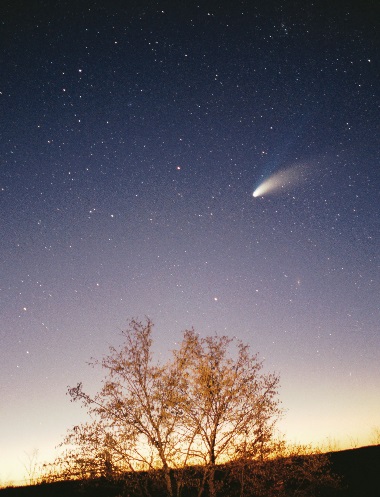
Meteoroid, Meteor and Meteorite
- A meteoroid is any solid debris originating from asteroids, comets or other celestial object and floats through interplanetary space.
- A meteor is the streak of light that appears in the sky when a meteoroid enters the atmosphere (mesosphere) at about 200 km at high speed and burns up because of the friction.
- A meteor is popularly termed a ‘shooting star’ or ‘falling star’.
- In some cases, the meteoroid does not burn up completely and makes its way to the Earth’s surface. The surviving chunk is called a meteorite.
- The circular depression created on the earth’s surface after the meteorite’s impact is called as a meteorite crater.
- Meteorite impacts are common on all planets and moons in the solar system.
- The most conspicuous meteorite craters can be found on the surfaces of the Moon and Mercury (because they are geologically inactive due to negligible atmosphere).
- Largest Meteor Crater: A meteor crater in Arizona (USA) is 1,300 m deep is the largest meteor crater in the world. It was formed over 10,000 years ago.
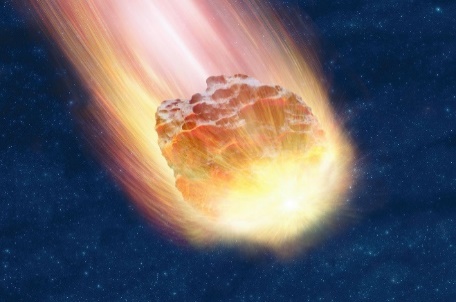
Chicxulub crater
- Chicxulub crater (Mexico’s Yucatan Peninsula) was caused by a meteor impact that is believed to have wiped out the dinosaurs (mass extinction at the end of the Cretaceous 65 million years ago).
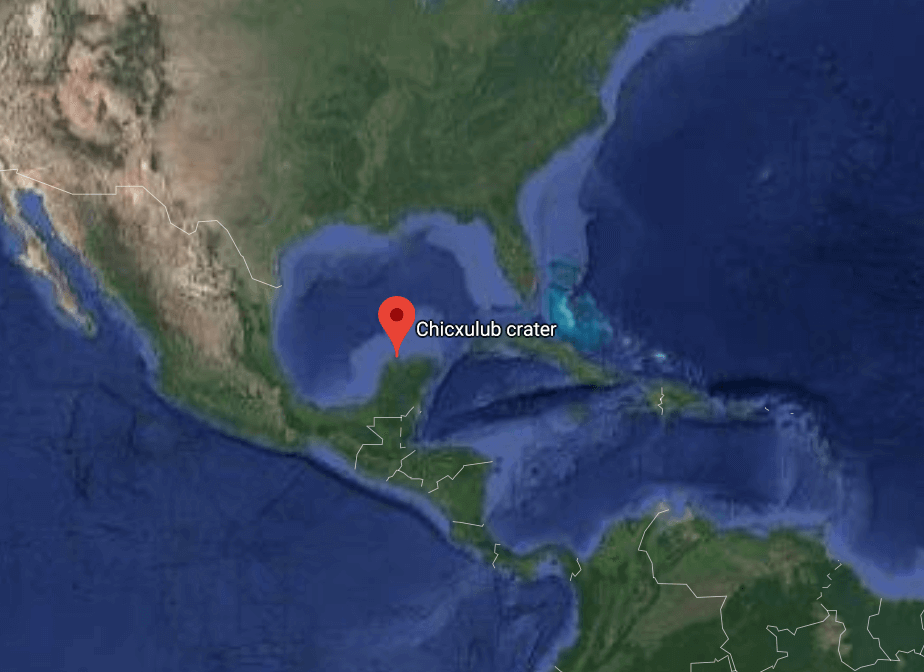
Meteorite craters in India
- Lonar Lake (1.8 km in diameter) in Buldhana District of Maharashtra
- Dhala crater (14 km in diameter) in Shivpuri district, Madhya Pradesh and
- Ramgarh crater (3.5 km in diameter) is a potential meteorite crater in Kota plateau in Rajasthan.



No comments